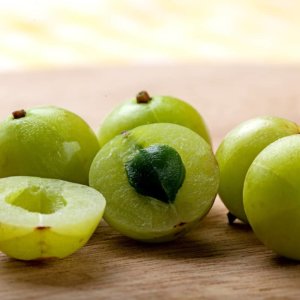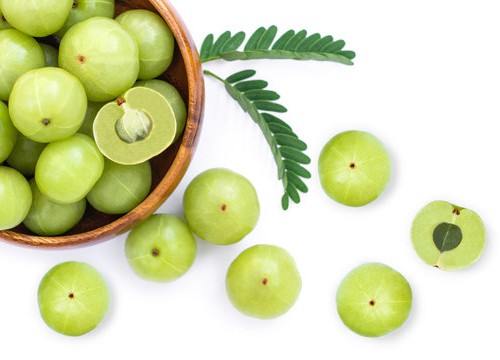We all know about the importance of eating good food to stay healthy (whether or not we actually follow through), but have you ever thought about what you “feed” your skin?
Your skin is the first line of defense your body has against the outside world. It’s constantly being stressed by toxins from the environment, chemical-filled skincare products, UV radiation, and so on. All of this takes a toll, depleting your skin of the “good stuff” and causing it to look old and worn out.
And if you aren’t replenishing your skin with the nourishment it needs, things are only going to get worse.
Thankfully, there are ways to restore and rejuvenate your skin, and amla extract is one of the best “superfoods” for the job. It has a long history of use in Ayurvedic medicine and is now recognized by many skincare experts as one of the best ingredients to achieve that elusive glowing complexion.
You really don’t want to miss out on the benefits of this super-fruit, so here’s a closer look at what it can do for your skin.
What is Amla Extract?
 Amla, also known as Indian gooseberry, is a small, sour fruit native to southeast Asia. Its botanical name is Phyllanthus emblica, and it grows on small- to medium-sized trees throughout India and nearby countries.
Amla, also known as Indian gooseberry, is a small, sour fruit native to southeast Asia. Its botanical name is Phyllanthus emblica, and it grows on small- to medium-sized trees throughout India and nearby countries.
The fruits are round, berry-like, and a light yellow-green color. They are highly nutritious, though with a very strong flavor that is often described as tart and bitter. In India, amla is frequently eaten with salt and chili powder to improve the flavor. It can also be pickled or made into a sweet, candied fruit.
Amla fruits do look very much like the European gooseberries (Ribes uva-crispa) that grow on spiny bushes, but they are actually unrelated and completely different from one another.
You can take amla in a few different ways. The fresh fruit is hard to find outside of where it grows natively, but you can usually find it as a powder, liquid extract, and sometimes frozen. Amla extract is the form most often used in skincare products because it’s concentrated and very powerful.
Uses in Ayurvedic Medicine
Amla may just be coming onto the scene in western parts of the world, but it has been used in Ayurvedic medicine for thousands of years.
In India, amla trees are widely considered to be sacred and used often in traditional medicine. The fruit is used as a rejuvenator and to balance the immune system in Ayurveda. It’s also believed to promote longevity, strengthen the heart, and enhance the intellect.
However, amla is perhaps most “famous” as being part of the revered Ayurvedic formula called triphala.
Triphala is a powder made up of three different dried and ground fruits: amalaki (Sanskrit for amla), haritaki, and bibhitaki. It’s used mainly as a digestive tonic and to promote longevity. Triphala is also notable for supporting each of the three doshas (kapha, vata, and pitta) and containing every taste except salty.
On its own, amla has also been used for skin and hair health for at least several centuries, so it’s not new to the skincare world at all.
Why Amla Extract is So Powerful for Your Skin
There is a lot we could go into as far as the health benefits of amla are concerned. But when it comes to your skin, amla’s superpowers come down to two main components: antioxidants and vitamin C.
Antioxidants: Superheroes for Your Skin
Antioxidants are a critical part of anti-aging skincare. Free radicals, which are unstable molecules that damage your cells, aren’t just a problem inside your body. They also cause destruction to skin cells when not kept in check and are a huge contributor to signs of aging like wrinkles, dark spots, and sagging skin.
Consuming antioxidants and applying them to your skin regularly is key to neutralizing free radicals and preserving the youthfulness of skin.
Amla berries are one of the highest antioxidant foods on earth. They have a huge ORAC value of 261,500, which is more than 50 times the amount found in blueberries!
There’s really only one other skincare ingredient (astaxanthin) that has a higher ORAC value, so amla is truly at the top when it comes to antioxidant protection for your skin.
Vitamin C: Age-Defying Antioxidant
To go just a little bit deeper into the skin benefits of amla, we need to look at a specific antioxidant: vitamin C.
Vitamin C, just by itself, is very powerful for your skin. It can boost collagen production, brighten skin tone, combat wrinkles and other signs of aging, and protect your skin from suffering more damage (more on all of that in just a bit).
Amla berries are packed full of vitamin C. They contain about 20-30 times the amount found in oranges and give your skin the vitamin-boost it needs.
Combined with the many other antioxidants found in amla, this makes one very potent skin superfood!
Specific Skin Benefits of Amla Extract
Boosts Collagen Synthesis
You probably know that boosting collagen is a good thing, but why exactly?
Collagen is one of the major proteins in your skin’s makeup, accounting for about 70% of it. It has many jobs and one of them is to keep skin plump and firm. As collagen diminishes (something that starts happening around age 20), skin becomes “looser” and thinner.
The end result is that wrinkles and fine lines start noticeably developing because skin is no longer as firm. You’ll also start to see areas that look more deflated and papery.
One of the keys to kickstarting collagen production is vitamin C, something we know amla extract is full of. And research confirms that it is beneficial for this purpose when applied topically as well as when consumed by mouth.
By promoting collagen synthesis, using it regularly can also improve skin thickness as well.
Gives Skin a Brighter Glow

Another frustrating development is hyperpigmentation, which again happens to most of us with age. Hyperpigmentation usually forms as a result of sun exposure, although it can also come from other sources like acne.
When your skin is exposed to sunlight, it produces melanin, a dark pigment that protects it from UV damage. This is what happens when your skin tans as you spend time out in the sun. At some point, however, you can develop dark spots of melanin on your skin that don’t fade like a tan will.
Most people call them age spots or sun spots, and they can be very stubborn.
Once again, the vitamin C in amla comes to the rescue. It helps to brighten your complexion as a whole and can also decrease pigmentation. Applying it regularly helps to reduce the appearance of dark spots and improves skin tone.
Reduces Inflammation
Amla extract also has benefits for red and inflamed-looking skin- once again due to the power of vitamin C.
Vitamin C has natural anti-inflammatory properties that have proven to be helpful for inflammatory skin conditions. You can also make use of it for occasional redness or inflamed patches of skin. As a bonus, your skin will likely feel less irritated, too.
Using vitamin C topically is great for making your skin look smoother as well. Applying it regularly helps to even out skin tone, something else that can get rougher as you get older.
Protects from Further Damage
Both the vitamin C and the other antioxidants in amla extract are powerful for protecting your skin from future damage.
Your skin gets attacked in many ways, but one of the biggest damage-causers is UV radiation from the sun. This is one of the most notable accelerators of free radical formation and can also accelerate the degradation of collagen.
Photodamage is the technical term for signs of aging caused by UV rays and includes wrinkles, dark spots, thinning skin, and much more.
Antioxidants in general- and vitamin C especially- can help protect your skin at the cellular level from both UV and free radical damage. Studies confirm this, and some have found that vitamin C has a “UV-protective effect” against both UVA and UVB rays.
Combining vitamin E (another nutrient present in amla) with vitamin C has a synergistic effect that limits UV damage even more.
Helpful for Damaged Skin
The collagen-boosting nature of amla extract is good for more than just fighting signs of aging. It can also help with damaged skin because it promotes skin repair.
Collagen is needed for every stage of the wound healing process your skin goes through after being injured. It’s integral to the makeup of blood vessels, tissues, and every layer of skin. If your body doesn’t have enough of it, wounds- even minor ones- will be slow to heal.
Because of this, vitamin C is also critical for healing damaged skin. Research shows that your body needs it to keep up collagen synthesis, and it may reduce scarring as well.
Good for Your Hair, Too
 Amla has a history of use for hair as well as skin. The extract is most frequently used to nourish dull hair and promote hair growth, something that new studies are backing up.
Amla has a history of use for hair as well as skin. The extract is most frequently used to nourish dull hair and promote hair growth, something that new studies are backing up.
In a 2012 study, amla was found to have potential for inhibiting an enzyme that contributes to hair loss. It was also found to promote hair growth, albeit in animals.
You can also make use of amla oil, another form of this versatile fruit, to condition dry hair. Or consume amla as a powder to boost healthy-looking hair from the inside out.
Other Fantastic Health Benefits of Amla
There’s no question that amla is excellent for brighter, more youthful-looking skin, but it is also health-promoting when used internally.
Boosts Immune Function
It shouldn’t come as any surprise that amla can boost your immune system. After all, it’s packed full of vitamin C, which is one of the most well-known immune strengtheners. In fact, there’s some evidence that vitamin C can reduce the duration of the common cold as well as improve immune cell function.
Supportive for Your Liver
A few studies have shown that amla berries are protective of liver health. They seem to be able to increase antioxidant levels in your liver, which helps it to function better and protects it from damage. Other research indicates that amla can help protect against liver toxicity (from heavy metals, etc.) and possibly even cancer.
Good for Heart Health
Consuming amla is particularly good for your heart. It can help reduce LDL (bad) and total cholesterol levels and may also lower blood pressure. One study even showed that it may be particularly helpful for those who are at higher risk of developing cardiovascular disease.
Aids Digestion
Amla fruit provides excellent support for your digestion. The berries are high in fiber, which helps prevent constipation. They also have a toning effect on your digestive system, easing discomfort and potentially calming heartburn as well.
Using Amla Extract for Your Skin
The best way to get the skin benefits of amla extract is to apply it to your skin daily. Look for it in a quality skincare product, preferably an organic one, with moisturizers added to keep your skin nourished. Other antioxidant ingredients are a great complement- as is vitamin E, which boosts the power of vitamin C.
You can also take amla as a powder (unless you can get the fresh fruit) to enhance topical use. The vitamin C in it will benefit collagen production and overall skin health when taken internally as well.
Look for a quality powder supplement that is organic and preferably tested for contaminants.
Feed Your Skin Anti-Aging Superfoods
 If you’re looking for an anti-aging product to “feed” your skin with, the Age-Defying Dream Cream from Purity Woods will do just that.
If you’re looking for an anti-aging product to “feed” your skin with, the Age-Defying Dream Cream from Purity Woods will do just that.
It features over 20 pure plant extracts, including the incredible amla berry, and is packed full of antioxidants and natural moisturizers. The cream is 100% USDA Certified Organic, which means no toxins or GMOs, and is both effective against signs of aging and gentle on your skin.
Use it to quickly erase the appearance of wrinkles, sun spots, fine lines, and saggy skin and restore a healthy glow to your complexion.
Look into the Age-Defying Dream Cream here, and don’t forget to try adding amla to your diet as well for an even greater boost!



